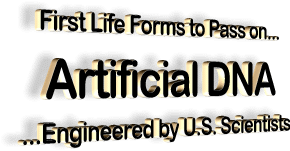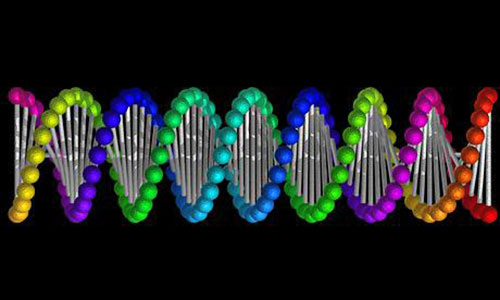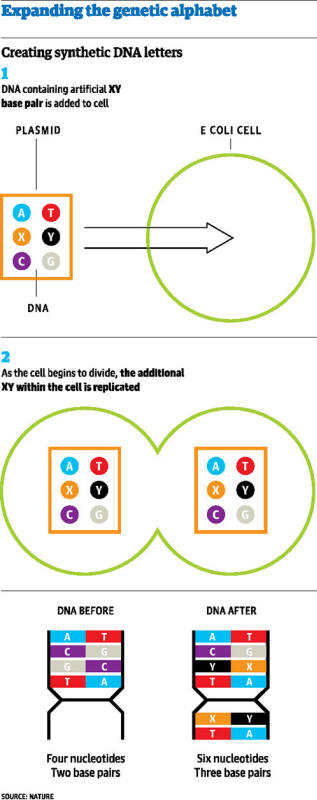|

by Ian Sample
7 May 2014
from
TheGuardian Website
Organisms carrying beefed-up
DNA code
could be designed to churn out
new drugs
that could not otherwise be
made

The latest
study moves life beyond the DNA code of G, T, C and A,
the molecules or
bases that pair up in the DNA helix.
Photograph: Scott
Camazine /Alamy
The first living organism to carry and pass down to future
generations an expanded genetic code has been created by
American scientists, paving the way for a host of new life forms
whose cells carry
synthetic DNA that looks nothing
like the normal genetic code of natural organisms.
Researchers say the work challenges the dogma that the molecules of
life making up DNA are "special".
Organisms that carry the beefed-up DNA
code could be designed to churn out new forms of drugs that
otherwise could not be made, they have claimed.
"This has very important
implications for our understanding of life," said Floyd
Romesberg, whose team created the organism at the Scripps
Research Institute in La Jolla, California.
"For so long people have thought
that DNA was the way it was because it had to be, that it was
somehow the perfect molecule."
From the moment life gained a foothold
on Earth the diversity of organisms has been written in a DNA code
of four letters.
The latest study moves life beyond G, T,
C and A - the molecules or bases that pair up in the DNA helix - and
introduces two new letters of life: X and Y.
Floyd Romesberg started out with
E coli, a bug normally found
in soil and carried by people. Into this he inserted a loop of
genetic material that carried normal DNA and two synthetic DNA
bases.
Though known as X and Y for simplicity,
the artificial DNA bases have much longer chemical names, which
themselves abbreviate to
d5SICS and dNaM.
In living organisms, G, T, C and A come together to form two base
pairs, G-C and T-A. The extra synthetic DNA forms a third base pair,
X-Y, according to the study in Nature.
These base pairs are used to
make genes, which cells use as templates for making proteins.

Romesberg found that when the modified bacteria divided they passed
on the natural DNA as expected. But they also replicated the
synthetic code and passed that on to the next generation.
That generation of bugs did the same.
"What we have now, for the first
time, is an organism that stably harbors a third base pair, and
it is utterly different to the natural ones," Romesberg said.
For now the synthetic DNA does not do
anything in the cell. It just sits there.
But Romesberg now wants to tweak the
organism so that it can put the artificial DNA to good use.
"This is just a beautiful piece of
work," said Martin Fussenegger, a synthetic biologist at ETH
Zurich.
"DNA replication is really the cream
of the crop of evolution which operates the same way in all
living systems. Seeing that this machinery works with synthetic
base pairs is just fascinating."
The possibilities for such organisms are
still up for grabs.
The synthetic DNA code could be used to
build biological circuits in cells which do not interfere with the
natural biological function; scientists could make cells which use
the DNA to manufacture proteins not known to exist in nature. The
development could lead to a vast range of protein-based drugs.
The field of synthetic biology has been controversial in the past.
Some observers have raised concerns that scientists could create
artificial organisms which could then escape from laboratories and
spark an environmental or health disaster.
More than 10 years ago, the scientist Eckard Wimmer, at Stony
Brook University, in New York, recreated the polio virus from
scratch to highlight the dangers.
Romesberg said that organisms carrying his "unnatural" DNA code had
a built-in safety mechanism. The modified bugs could only survive if
they were fed the chemicals they needed to replicate the synthetic
DNA.
Experiments in the lab showed that
without these chemicals, the bugs steadily lost the synthetic DNA as
they could no longer make it.
"There are a lot of people concerned
about synthetic biology because it deals with life, and those
concerns are completely justified," Romesberg said. "Society
needs to understand what it is and make rational decisions about
what it wants."
Ross Thyer, at the University of
Texas, in Austin, suggested the synthetic DNA could become an
essential part of an organism's own DNA.
"Human engineering would result in
an organism which permanently contains an expanded genetic
alphabet, something that, to our knowledge, no naturally
occurring life form has accomplished.
"What would such an organism do with
an expanded genetic alphabet? We don't know.
Could it lead to more sophisticated
storage of biological information? More complicated or subtle
regulatory networks? These are all questions we can look forward
to exploring."
|


